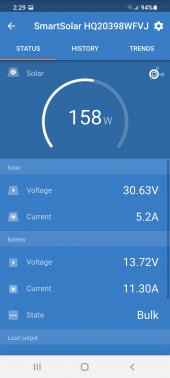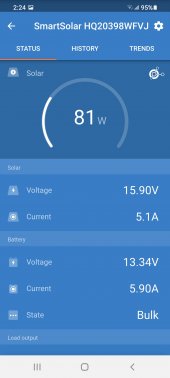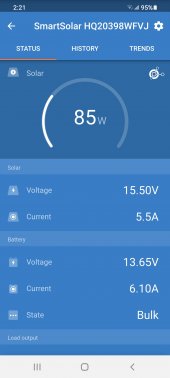Hi, I have two 100 Watt SunPower flexible solar panels and a Victron Smartsolar 100/20 mppt controler I am planning on using as a portable system to supplement my solar and battery system in my RV. When I connect either panel to charge controler I get @ 80Watts output. If I connect the panels in series @160Watts when I connect the panels in parallel I only get @115 Watts, any thoughts?
You are using an out of date browser. It may not display this or other websites correctly.
You should upgrade or use an alternative browser.
You should upgrade or use an alternative browser.
Low panel out put with panels in parallel configuration
- Thread starter BobW
- Start date
OffGridICF
New Member
- Joined
- Aug 5, 2021
- Messages
- 41
Assuming you have the RNG-100DB-H 100W flexible panels, it looks like the output voltage of the panels is too low (not enough sun?, shading?, dirty?) to place them in parallel and still get the rated power output. The max rated output of the panels is 100W with 5.29A * 18.9V (peak of green line in plot below in Watts on right axis). Looking at the I-V curve you are probably operating near 80W at 5.75A * 13.9V (magenta line added to plot below). With the panels in series, the MPPT will see 27.8V on the input and can output enough voltage to charge the batteries with 160W. With the panels in parallel, the MPPT input will be 13.9V so the MPPT output voltage may be too low to charge the batteries with more than 115W. The current accepted by the batteries is a function of the voltage and state of charge. You can confirm this by measuring the panel and battery voltages.


Assuming you have the RNG-100DB-H 100W flexible panels, it looks like the output voltage of the panels is too low (not enough sun?, shading?, dirty?) to place them in parallel and still get the rated power output. The max rated output of the panels is 100W with 5.29A * 18.9V (peak of green line in plot below in Watts on right axis). Looking at the I-V curve you are probably operating near 80W at 5.75A * 13.9V (magenta line added to plot below). With the panels in series, the MPPT will see 27.8V on the input and can output enough voltage to charge the batteries with 160W. With the panels in parallel, the MPPT input will be 13.9V so the MPPT output voltage may be too low to charge the batteries with more than 115W. The current accepted by the batteries is a function of the voltage and state of charge. You can confirm this by measuring the panel and battery voltages.
View attachment 65121
I have two SunPower SPR-E-FLEX-100 PANELS VMP 17.5 IMP5.8
I'm assuming the lose compared to rated power is from haze from California wildfires. what I'm trying to understand is the difference between the two panels in parallel vs series
Series conection
Attachments
wiseacre
Solar Addict
I'm just guessing, I'm only beginning to understand how things actually work. If I'm off base I hope someone corrects my thinking.
As I understand it, a MPPT SCC will take voltage and magically turn it into amps. When your array is in parallel there's not much extra voltage to transform. It appears in series there's plenty of voltage to manipulate and you're getting a slightly better return.
But all things considered it is probably just the amount of solar energy hitting the array. I see similar differences in wattage without noticing any significant change in sunlight. My Victron is much more sensitive to solar than I am. Like you say it could just be haze.
As I understand it, a MPPT SCC will take voltage and magically turn it into amps. When your array is in parallel there's not much extra voltage to transform. It appears in series there's plenty of voltage to manipulate and you're getting a slightly better return.
But all things considered it is probably just the amount of solar energy hitting the array. I see similar differences in wattage without noticing any significant change in sunlight. My Victron is much more sensitive to solar than I am. Like you say it could just be haze.
@98% I also had a 250 watt load on battery while testing. The charge controller shows bulk charge in series, parallel or individually.What’s the state of charge of the battery?
OffGridICF
New Member
- Joined
- Aug 5, 2021
- Messages
- 41
TL:DR MPPT converts power from the panel at a higher voltage to an almost equal amount of power at the battery at a lower voltage. Victron says there must be at least 2V difference for the MPPT to provide the best performance. In the individual panel case, you are very close to this 2V limit so the MPPT output will be less than expected. In the parallel case, there is more input power from the panels but you are still close to the 2V limit. In the series case, you have much more than 2V difference from PV to battery so the MPPT can work more effectively.
More details:
Looking at the RNG-100DB-H 100W panel I-V curve I included above (similar to your panels but not the exact curve since I couldn't find it) you will notice that the panels output the same current near 5.75A for a wide range of voltage. The panel output power is the voltage * amps. If you operate the panel at less than V(max power) or Vmp, you will lose output power. For example, the same panel with the same amount of sun with the output directly connected to a battery at 14.4V * 5.75A = 82.8W. You lose 100W - 82.8W = 17.2W. You can see that by looking at the green line with the power in Watts on axis on right.
The MPPT circuit adjusts the panel output voltage to find the place where its output power is maximum, the peak in the green line. For this panel in full sun, that will happen when Vmp is around 18.9v * 5.29A = 100W. With MPPT, the panel output voltage can vary while the battery stays at 14.4V. The power to the battery will be close to the power from the module (minus some small loss to operate the MPPT), but since the voltage is different, the current must also be different. From the panel, 100W / 18.9V = 5.29A. To the battery, 100W / 14.4V = 6.9A.
Check out this paper from Victron for more details:
https://www.victronenergy.com/blog/...ar-modules-to-the-new-mppt-charge-regulators/
Since the Voc of your two panels in series is around 40V, well below the MPPT maximum input of 100V, it would be much better to connect them in series. With more intense sun, the panel output will increase so you might get the full output with them in parallel. Series will give better results on cloudy (or smoky) days. Parallel might make sense if one of the panels is shaded or they face opposite directions.
Without the 250W load you added your almost fully charged battery would not draw much power from the panels. Adding the 250W load is a good way to take that factor out of the equation.
More details:
Looking at the RNG-100DB-H 100W panel I-V curve I included above (similar to your panels but not the exact curve since I couldn't find it) you will notice that the panels output the same current near 5.75A for a wide range of voltage. The panel output power is the voltage * amps. If you operate the panel at less than V(max power) or Vmp, you will lose output power. For example, the same panel with the same amount of sun with the output directly connected to a battery at 14.4V * 5.75A = 82.8W. You lose 100W - 82.8W = 17.2W. You can see that by looking at the green line with the power in Watts on axis on right.
The MPPT circuit adjusts the panel output voltage to find the place where its output power is maximum, the peak in the green line. For this panel in full sun, that will happen when Vmp is around 18.9v * 5.29A = 100W. With MPPT, the panel output voltage can vary while the battery stays at 14.4V. The power to the battery will be close to the power from the module (minus some small loss to operate the MPPT), but since the voltage is different, the current must also be different. From the panel, 100W / 18.9V = 5.29A. To the battery, 100W / 14.4V = 6.9A.
Check out this paper from Victron for more details:
https://www.victronenergy.com/blog/...ar-modules-to-the-new-mppt-charge-regulators/
Since the Voc of your two panels in series is around 40V, well below the MPPT maximum input of 100V, it would be much better to connect them in series. With more intense sun, the panel output will increase so you might get the full output with them in parallel. Series will give better results on cloudy (or smoky) days. Parallel might make sense if one of the panels is shaded or they face opposite directions.
Without the 250W load you added your almost fully charged battery would not draw much power from the panels. Adding the 250W load is a good way to take that factor out of the equation.
A single panel would be 1v above the fully charged batteryWhen I connect either panel to charge controler I get @ 80Watts output. If I connect the panels in series @160Watts when I connect the panels in parallel I only get @115 Watts, any thoughts?
Two panels in parallel would only be slightly above that 1v
Two panels in series would be 16.9v above the battery V ....so more PV wattage in proportion to that from the battery would go to load as your figure indicate.
In this context MPPT doesn't enter in to it
I would discharge your batteries down to 50-70% and test again.@98% I also had a 250 watt load on battery while testing. The charge controller shows bulk charge in series, parallel or individually.
I am still learning, but I think MPPT controllers work better with higher voltage. They have more room to find the most efficient charge. I think your 100 volt controller will be more happy with 30 volts instead of 16 volts.As I understand it, a MPPT SCC will take voltage and magically turn it into amps. When your array is in parallel there's not much extra voltage to transform. It appears in series there's plenty of voltage to manipulate and you're getting a slightly better return.
Similar threads
- Replies
- 9
- Views
- 202
- Replies
- 19
- Views
- 531
- Replies
- 5
- Views
- 495






